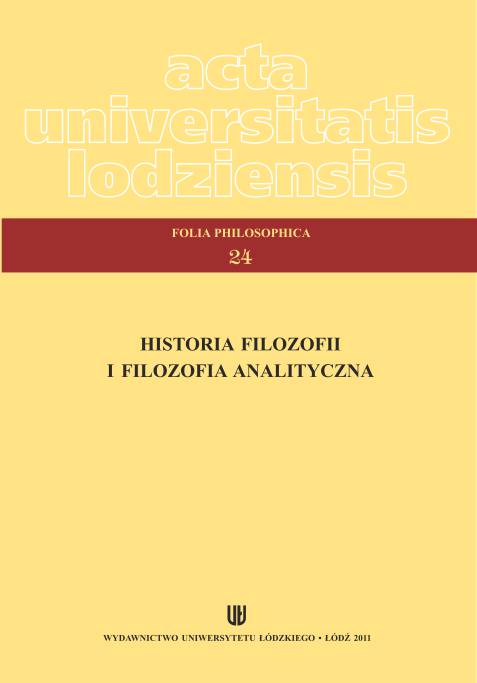"De vita coelitus comparanda" Marsilia Ficina jako przedstawienie hermetycznych praktyk odnowy człowieka
DOI:
https://doi.org/10.18778/0208-6107.24.03Abstrakt
The aim of this article is a reconstruction and interpretation of Marsilio Ficino's thoughts presented in "De vita coelitus camparanda" that, having a hermetic tinge to it, concern an idea of human's religious tranformation. In the article I attempt to demonstrate that "De vita coelitus camparanda" is a treaty of religious character which, contrary to the author's intentions, is closer to pagan religiousness than the christian one. Natural-magical efforts oficially presented by Ficino and efforts of demonic and ceremonial character suggested by him in some parts of the text constitute a complex of religious practices of hermetic origin that serve a purpose of human evolution. Methodology characteristic of magic — methodology that is subjectivistic but at the same time assumes that the human is a cosmos in micro scale, and a truly hermetic vision of reality indicate such a path of human’s rebirth that has no purely personal or local meaning but possesses a cosmic dimension.
Bibliografia
Allen M.J.B, The Absent Angel in Ficino’s Philosophy [w:] „Journal of the History of Ideas”, vol. 36, no. 2, ss. 219–240, University of Pennsylvania Press.
Google Scholar
DOI: https://doi.org/10.2307/2708925
Baigent M., Leigh R. 1998, Eliksir i kamień, tłum. A. Kowalska, Amber, Warszawa.
Google Scholar
Ficino M. 1989, Three Books on Life. A Critical Edition and Translation with Introduction and Notes, by C. V. Kaske, J. R. Clark, New York: Center for Medieval and Early Renaissance Studies at the State University of New York at Binghamton, [podst. wyd.:] Ficino M, 1489, De vita libri tres, Florence.
Google Scholar
Garin E. 1987, Powrót filozofów starożytnych, tłum. A. Dutka, PAN IFiS, Warszawa.
Google Scholar
Garin E. 1992, Zodiak życia, tłum. W. Jakiel, PAN IFiS, Warszawa.
Google Scholar
Gilson E. 1953, Wprowadzenie do nauki św. Augustyna, tłum. Z. Jakimiak, PAX, Warszawa.
Google Scholar
James J. 1996, Muzyka sfer, tłum. M. Godyń, Znak, Kraków.
Google Scholar
Jonas H. 1994, Religia gnozy, tłum. M. Klimowicz, Platan, Kraków.
Google Scholar
Jung C. G., 1989, Rebis czyli kamień filozofów, tłum. J. Prokopiuk, PWN, Warszawa.
Google Scholar
Jung C. G., 1993 Wspomnienia, sny, myśli, tłum. R. Reszke, L. Kolankiewicz, Wrota-KR, Warszawa.
Google Scholar
Kaske C. V., Clark J. R. 1989. Introduction and Commentary Notes [w:] Ficino, 1989, ss. 3–90, 409–460.
Google Scholar
Kerényi K. 1997, Dionizos. Archetyp życia niezniszczalnego, tłum. I. Kania, Baran i Suszyńki, Kraków.
Google Scholar
Klibansky R., Panofsky E., Saxl F. 2009, Saturn i melancholia, tłum. A. Kryczyńska, Universitas, Kraków.
Google Scholar
Kristeller P. O. 1943, The Philosophy of Marsilio Ficino, transl. by V. Conant, Columbia University Press, New York.
Google Scholar
Lovejoy A. 1999, Wielki łańcuch bytu, tłum. A. Przybysławski, KR, Warszawa.
Google Scholar
Plotyn 1959, Enneady, t. 2, tłum. A. Krokiewicz, PWN, Warszawa.
Google Scholar
Rijckenborgh J. van 1997, Pragnoza egipska, t. 1, tłum. Wspólnota Nauk Różokrzyża, Rozekruis Pers, Wrocław
Google Scholar
Rijckenborgh J. van, brak daty wydania. Pragnoza egipska t. 3. Tłumaczyła Wspólnota Nauk Różokrzyża. Wrocław: Rozekruis Pers.
Google Scholar
Walker D. P. 1958, Spiritual and Demonic Magic. From Ficino to Campanella, The Warburg Institute University of London, London.
Google Scholar
Yates F. 1964, Giordano Bruno and the Hermetic Tradition, Routledge and Kegan Paul, London.
Google Scholar
Yates F. 1977, Sztuka pamięci, tłum. W. Radwański, L. Szczucki, Państwowy Instytut Wydawniczy, Warszawa.
Google Scholar
Zambelli P. 1994, Mit hermetyzmu i aktualna debata historiograficzna, tłum. P. Bravo, PAN IFiS, Warszawa.
Google Scholar
Pobrania
Opublikowane
Jak cytować
Numer
Dział
Licencja

Praca jest udostępniana na licencji Creative Commons Attribution-NonCommercial-NoDerivatives 3.0 Unported License.












